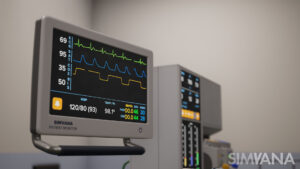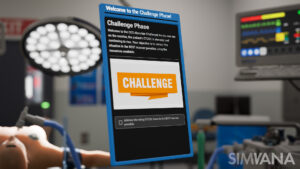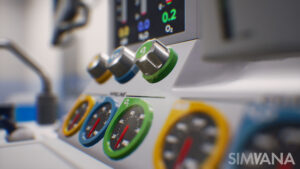Many great technology companies got their start in Huntsville. One of those companies is Torch Technologies, but I was a little surprised recently when I saw a tweet about the launch of the company’s first commercial product, an anesthesia trainer called SIMVANA.
SIMVANA uses virtual reality technology to simulate an active operating room environment where anesthesiology students can learn all about the equipment and the environment in which they will be working.
Hmm, I didn’t know Torch Technologies was into medical technology, I thought.
As it turns out, they weren’t.

Not until 2018 — that is when Darryl Trousdale, the company’s senior manager over their Advanced VIZLAB (AVL), had a chance conversation with his next-door neighbor, Peter Stallo, president of Prodigy Anesthesia.
“In Huntsville, nobody knows what anyone else does,” Peter Stallo laughed recalling the occasion. “I knew Darryl did something with the military at Torch Technologies. One day we were talking and I described what I was working on. He asked to see it so I took him to my office above my garage and showed it to him.”
Peter Stallo CRNA is a nurse anesthetist and a Ph.D. student in health care simulation at the Institute for Health Professions at Massachusetts General Hospital. His company, Prodigy Anesthesia, provides continuing education for professional anesthetists, and trains nursing anesthesiology students how to prepare for their board certifications.
“A lot of my work is creating content related to anesthesia for videos and computer animations showing how different physiological processes work, how different pieces of equipment work,” he told me. His own on-the-job training experience gave him the idea for the virtual reality learning tool.

“I saw my first anesthesia machine the same day I saw my first operating room and it was an overwhelming experience,” Peter advised. “The equipment in an operating room is very expensive, so students don’t have access to it prior to the live event. You are usually in the OR as an apprentice, but once you get in there, it becomes information overload. It completely overwhelms you as you begin building the jigsaw puzzle you have to put together in the operating room.”
But that is not the most compelling reason for Stallo’s idea.
In the United States, Europe and Japan, anesthesia is very safe. Peter said the risk of dying from anesthesia in the developed countries is one in 300,000 — some say one in a million. But elsewhere, in third-world countries, that number is as high as one in 300, making it 1,000-times more likely to die under anesthesia in those regions of the world.
“Those countries do not have the financial resources for the training and without training, there is not enough personnel to serve a large population,” he explained.
“What if I can develop that virtual anesthesiology training environment so it can go anywhere in the world and train people?” he asked rhetorically.
In 2018, Peter downloaded a free open-source advanced real-time 3D creation tool and created a “crude” mock-up of a virtual operating room, based on his intimate knowledge of the environment and machines involved.

It is at this point in my conversation with Peter and Alex that I notice dozens of pictures on the wall of what I assumed was Torch Technologies on display via military vehicles on the battlefield.
That was when Alex Engelmann, now project lead for SIMVANA but who also manages a team of Torch developers who do virtual reality simulations for the military, pointed out to me the images I was looking at were not live battlefield shots, but simulations from Torch’s virtual environment.
“They use it to train military students, so they don’t have to train on a $40 million THAAD missile system,” Peter exclaimed.
Seeing my surprise, Peter pointed to the images, saying, “After that first meeting and seeing the work Torch does, I was horrifically embarrassed to show them my drawings!”
However, Peter’s idea passed the Torch Technologies board of directors, and it was decided Torch could take the work they are already doing and apply it to Peter’s medical application using existing talent and skills they already have within the company.
I was curious though – isn’t the medical technology industry using virtual reality for all types of medical training?
Peter said they have some virtual training technology for orthopedic surgeons on how to install total knee replacement hardware and some other surgical procedures, but nothing in the field of anesthesia,
“Really, SIMVANA is a trainer for the decision-making skills you need as an anesthesiologist in the operating room,” he said.
Peter and Alex were anxious for me to experience SIMVANA, but I was shy to admit I have never used VR and never even played a video game where you move around and interact using game controllers in each hand.
This was going to be interesting!
See the Simvana video below:
Everything in VR is basically a touch-based panel, Alex said, so all I have to do is slide around and poke things. But with no experience using controllers in each hand, I moved around like Frankenstein’s monster, stumbling my way down the virtual hospital hallway and entering the operating room where I tripped over the patient’s bed with the patient in it, crashed into the anesthesia machine, and bumped my head “virtually” on an overhead monitor.
It was a very immersive experience! I picked up my clipboard and then immediately dropped it on the floor. No need to stoop over. All I had to do was rotate my left hand, and, like a great wizard, I picked up my clipboard without physically bending down.
I wandered around the virtual operating room for a few minutes taking in the furnishing and signage. I have only been in an OR once when I broke both of my feet, but I don’t remember it, so it was fun opening cabinet doors and drawers and finding things Peter said I could expect to see in a real operating room.
One of the instructions was to disconnect the anesthesia circuit, so I grasped it where it is connected to the breathing tube and pulled up, disconnecting the anesthesia but accidentally dropping it on the floor.
Most VR simulations, Alex told me, are one-track — that is, you cannot veer outside of the script.
He advised, “SIMVANA is built on an open world, meaning the simulation will account for every single possibility, anything that can happen, and everything a user might do that veers off script will have consequences if you do.”
According to Peter, it is not uncommon during an anesthetic for the circuit to come disconnected, but I still envisioned my patient writhing in pain as it took me forever to reattach it before the patient’s oxygen levels drop.
My fumbling is a result of my lack of background in nursing or VR, but it is clear the point of the training is to teach you what to do in almost any scenario.
SIMVANA can simulate power outages, emergency procedures, Code Blue protocols, how to handle rare medical reactions to the anesthesia, as well as applications for learning all the components of the anesthesia machine and other equipment.
Torch Technologies currently has four full-time developers: Dylan Barret, Blake Driggers, Andre Domingue and Engelmann are all assigned to the project. Two to three artists step in when needed, and there is a designer who works on the interface.
Torch Technologies and Prodigy Anesthesia released a BETA version of SIMVANA to its first commercial customer, Southern Illinois University in Edwardsville last spring. Torch plans to fully release SIMVANA to hospitals and universities worldwide in April.
Simvana comes as licensed, downloadable software. A PC and a headset are all you need.
Last month, the Torch Advanced VIZLAB, in collaboration with Prodigy Anesthesia and Epic Games presented SIMVANA to the Serious Play 2021 conference.
“Virtual reality is based on gaming technology,” said Alex.
256 Today is looking for great stories from Huntsville technology companies and entrepreneurs. If you have technology that is finding commercial use or a different use from what it was created for, send your ideas to me at [email protected]
Don’t miss out! Subscribe to our email newsletter to have all our smart stories delivered to your inbox.



